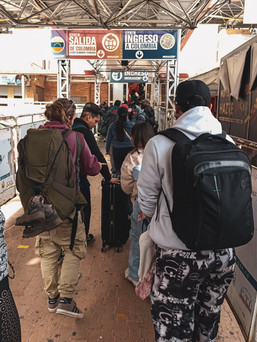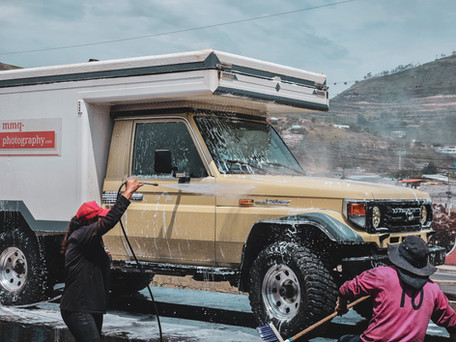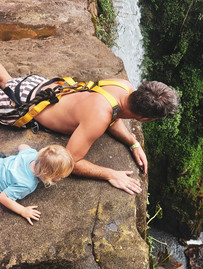Endless water - rainy season in Colombia
- michaelmarquardt07
- Nov 22
- 6 min read
Another emergency state in Ecuador
After a 10-month staycation in Europe, we're ready to continue our journey. Our beloved expedition vehicle is parked in the far north of Ecuador, near the Colombian border. It seems to us that Ecuador is never truly at peace. We're not primarily referring to the cartel wars and the recent sharp rise in the murder rate, which is increasingly reported in Europe; as tourists, this affects us very little – regrettable as it is. What really bothered us last year were the power outages, during which virtually everything came to a standstill. This year there's enough electricity; unfortunately, the government has decided to reduce long-standing diesel subsidies. This is particularly unpopular with the indigenous population, who are heavily dependent on the agricultural sector. So, there are the usual roadblocks, which bring traffic to a standstill in many places. Normally, negotiations ensue, eventually leading to the resolution of the blockades. This time, however, the positions seem entrenched.
Flight into Ecuador and then?
We're starting our journey from Mallorca/ Madrid, from where there are great overnight flights to Quito, Ecuador. We booked these several weeks in advance, back when everyone still expected the strike to end quickly. From Quito, it should only take us about two hours to reach Ibarra, where our car is parked. However, taking all the roadblocks into account, it would take us 12 hours by taxi. Adding in the flight and transit times, we'd probably be on the road/ in the air for around 30 hours – and that with a two-year-old. Micha (the epitome of impatience) is panicking – so our planning machine is working overtime in Mallorca. But sometimes you get lucky! When our flight to Quito is canceled at short notice, we breathe a sigh of relief. After some deliberation and many phone calls, we come up with a much more relaxed itinerary. And so, a few days later, we fly via Bogota to Ipiales in Colombia. From there, it's (in theory :-)) only two hours to our expedition vehicle.

The journey begins – but of course not as expected.
The flights are going almost too well, and we suspect our luck is about to run out. This proves true when our taxi driver in Ipiales informs us that the border to Ecuador is closed today at short notice due to local elections. Apparently, it will reopen "already" at 4:00 PM. That's still seven hours to go. As we approach the border, we meet two gringos, Bigna and Dave from Switzerland, who are also stuck with their vehicle and have set up camp at a nearby campsite. Luckily for us, they provide us with food and coffee! We are incredibly grateful. Diego even gets a cake; it's his second birthday today.
In the afternoon, we set off towards the border. The waiting crowd made us fear that we wouldn't be able to cross today. Contrary to expectations, we arrived in Ecuador around 6:00 PM and got into our taxi, stopping at a supermarket to buy alcohol. We desperately needed it to calm down. The rest went according to plan, two hours later we were back at our car. We put our luggage in the cab, set up the camper, and went to sleep—we weren't capable of anything more.
Repairs and big goals
We experienced virtually no jet lag over the following days – the great thing about an overnight flight.
So we were ready for the upcoming repairs; we had brought the spare parts with us from Europe. Among other things, we wanted to get our refrigerator working again and replace the faucet. Everything went smoothly, and no further problems arose (not even in the coming weeks). We were surprised after 10 months of the car being parked.
We could now fully dedicate ourselves to planning our trip. As we started planning, it made sense to leave Ecuador as soon as possible, since road closures were expected everywhere. Luckily, we had already seen a large part of the country last year. Let me tell you, Ecuador is truly beautiful and diverse. Unfortunately, Marion had already been training for several months to climb the Cotopaxi volcano, the only region in Ecuador we still wanted to visit.
Conflict resolution in South America and "Postponed is not abandoned"
Almost within a few days, the roadblocks disappeared. Following an eviction order from the military, things were carried out swiftly – largely without resistance. Of course, only on paper – incidents were allegedly covered up. Unfortunately, the removal of the roadblocks didn't help us either; now the weather gods were on our side, and the weather around Cotopaxi was dreadful. Too dreadful for the necessary acclimatization hikes with a toddler. So, with heavy hearts, Marion said goodbye (for now) to her climbing goal, and we fled to Colombia.
First impressions in Colombia
We'd barely arrived in Colombia when we experienced firsthand what the term "rainy season" really means. Luckily, it mostly only rained at night. Even so, our campsites were frequently flooded. Our first stop in Colombia was the church in Las Lajas, which sits spectacularly above the Guáitara River. This Colombian sanctuary, built in the Neo-Gothic style, was constructed between 1916 and 1945. We reached the church in true Colombian style by cable car, just like the ones we know from our ski resorts. Then we continued slowly northwards. We planned to drive from Mocoa to Pasto via the world-famous "Trampoline of Death."


Before heading to the trampoline park, we spent the night in the charming village of Sibundoy. We lucked out with a perfect sunny evening, which we spent at the local sports field. After consulting with the police, we camped for the night in the central village square.

The next morning, we wanted to get an early start, but we were stopped by police officers, supposedly because our wastewater tank was leaking. To be honest, it wasn't completely sealed anymore, but nobody had ever cared before. After all, it's just dishwater. The officers, however, were persistent and checked all our paperwork several times. The car was inspected – always with their hand on their gun; they seemed just as nervous as we were. After much back and forth, they slapped us with a fine of $1,000 (!!!) for contamination and threatened to impound our vehicle if we didn't pay. Now we were really annoyed, and Micha immediately took photos of the officers, as an evidence. You hear about corrupt police officers from time to time. In the end, we don't know what changed the officers' minds, but after apologizing profusely, we were released with the instruction to seal the tank in the next village.

Trampolin de La Muerte
Now we can finally get going. The roughly 80 km long stretch is considered one of the most dangerous roads in the world and the most dangerous in Colombia. It has only one lane (about 3 meters wide), is mostly unpaved, and in some sections has up to 18 curves per kilometer. The route is extremely dangerous due to unstable terrain, constant rain, dense fog, and landslides. There are drops of up to 300 meters. At least, that's the AI's summary. So far, so good. After 1.5 years in South America, we'd describe it as an average road with wonderful views. The only thing that's really annoying here is the high density of trucks due to its importance for north-south traffic. We got used to reversing for oncoming traffic in Peru and Bolivia, and this trampoline-like road certainly won't make our top 20 list of the most dangerous roads.

The end of the world
Having reached the other side of the pass, we quickly notice the change in temperature. Mocoa is located in a subtropical zone, where the humidity and heat are intense. Nevertheless, we have a little activity planned. We want to hike to the "Fin del Mundo" waterfall, supposedly about two hours one way, so we put Diego in the carrier and, just to be safe, put on our hiking boots. The path there is a steady uphill climb over slippery, perpetually wet, and mossy rocks. Our shoes offer almost no grip; neoprene water shoes would have been more appropriate. We're dreading the return trip downhill. Three river crossings later, we actually reach the beautiful waterfall on time – which you can only really see by looking over the edge. So, everyone puts on their harnesses, and then we start scrambling towards the end of the world. Diego certainly enjoys it. On the way back, we're advised to take off our hiking boots and walk in our socks on the extremely slippery sections. Our initial skepticism quickly fades, because it works. Clumsy gringos :-)

San Augustin in the footsteps of an unknown culture
On our way to the Tatacoa Desert, we stopped in the idyllic town of San Agustín. The climate here suited us very well, as it cools down considerably at night. The humidity also seemed to be somewhat lower.
The excavations at San Agustín are among the most important pre-Hispanic sites in South America. They are particularly known for their stone sculptures and burial mounds. The culture that created these monuments is largely unknown, but their legacy provides insights into their ritual burial practices and mythology.
We visited one of the sites. Anyone who knows us knows that while we are generally interested, we don't feel the need to see every single pile of stones. So, after three hours, we were happy to stop at a nice café. Nevertheless, we enjoyed the atmosphere of the very extensive site.











































Comments